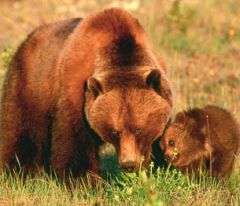Reducing roads could boost bear population

Alberta's scant grizzly bear population could grow by up to five per cent a year if fewer logging roads are built in the animals' habitat, according to University of Alberta researchers.
A study conducted by biologists Scott Nielsen and Mark Boyce showed that, regardless of any ecologically friendly harvesting practices adopted by industry, if road density is not reduced in logging areas, the grizzly population may continue to decline. It is estimated that there are currently less than 500 grizzly bears in Alberta.
The study, conducted in a 9,800 square-kilometre area of west-central Alberta that includes parts of Jasper National Park, compared current harvesting practices that use small clearcuts in a checkerboard pattern, with one that would mimic a naturally-occurring disturbance like a wildfire, resulting in large clear-cut areas. The second method is thought to be more environmentally friendly to the animals, but was found by the researchers to have little benefit because of associated roads.
The U of A study tracked 40 grizzlies fitted with GPS radio collars. Their foraging and bedding patterns were monitored over a five-year period and the two potential future landscapes relating to forest harvest patterns were modelled for the next 100 years. The results showed that while both harvesting scenarios increased overall habitat conditions for the bears, that benefit was offset by increased risk of human-caused mortality associated with roads.
Roads in and out of logging areas increase the animals' risk of death though human-bear conflict, vehicle-caused collisions, poaching and displacement from feeding and habitat areas.
The results were published recently in the journal Biological Conservation.
"No matter what kind of forestry harvesting practices are used, without reducing human access to grizzly habitat, the population remains threatened," said Boyce, a professor in the Department of Biological Sciences.
"Road development, access management and human attitudes are far more important factors to Alberta grizzly populations than the size and shape of clearcuts," said Nielsen, an assistant professor in the U of A Department of Renewable Resources.
With controlled access to logging areas, Boyce estimated that the province's beleaguered bear population could increase by up to five per cent a year, based on a similar situation in the Yellowstone ecosystem. In 1983 road controls were placed on grizzly habitat there, and the population has since grown from 183 bears to more than 600. "With careful management, we should be able to achieve a similar growth rate in Alberta," he said.
"Ideally, unnecessary roads would be decommissioned or gated by industry and limits on road development identified."
Source: University of Alberta



















